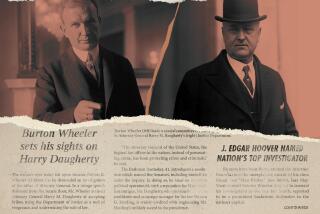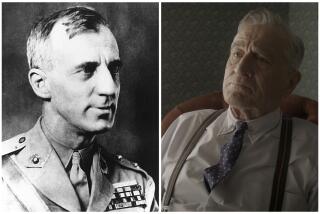Founding Father frenemies Hamilton and Burr ‘Duel With the Devil’
- Share via
History may be written by the victors, but Alexander Hamilton became a victor by writing history. He died at the hands of lifelong rival Aaron Burr in a famous duel, yet posterity has been kinder to Hamilton because of the power of his pen.
During his lifetime, Hamilton couldn’t stop Burr from eclipsing him politically — Burr became vice president and invented the Democratic Party , while Hamilton’s career died with George Washington. But with years of letters impugning Burr’s motives and morals, Hamilton was able to sway enough opinions to deny Burr a second term as vice president and the governorship of New York. And when Burr had had enough and challenged him to a duel, Hamilton made himself a martyr and Burr a legendary villain, by penning one last letter claiming he planned to fire into the air.
Now Hamilton’s face is on the $10 bill and his prolific writings have ensured his niche as a conservative hero. There’s a small contemporary crowd that would laud Burr as a liberal forebear — war hero, feminist, foe of slavery — but his case can be hard to argue because of gaps in the text. Many of Burr’s papers were lost at sea, and his surviving diary lists sexual feats, not political beliefs.
Sign up for “Bookshelf,” our email newsletter
In his new book “Duel With the Devil: The True Story of How Alexander Hamilton and Aaron Burr Teamed Up to Take on America’s First Sensational Murder Mystery,” Paul Collins recounts how Burr and Hamilton, the original frenemies, shared dinner tables and courtrooms for years before their fatal meeting and how their rivalry endures today. The fight at the heart of the book, however, is not this deathless battle between Teams Burr and Hamilton but a different war of words. Two centuries ago, Burr and Hamilton joined forces in the nation’s first well-documented murder trial to save a young carpenter from the gallows. As in all things Burr-Hamilton, however, there’s controversy over which man was the bigger hero of the tale.
At 8 p.m. Dec. 22, 1799, 22-year-old Elma Sands left her cousin’s boarding house and disappeared into Manhattan’s dark and snowy streets on a mysterious errand. When she was found floating in a well two weeks later, suspicion turned to fellow boarder Levi Weeks, who had allegedly seduced Sands and then killed her when she wanted to wed. Both Hamilton and Burr, chronic debtors, owed money to Weeks’ brother, and they agreed to defend Levi free of charge.
Collins, an author and writing professor at Portland State University who’s appeared on National Public Radio as a “literary detective,” paints a rich portrait of post-Revolutionary Manhattan, a muddy little burg wracked by fever and drink, where everyone knew everyone. Nearly every man in the courtroom, from judge to juror, owed political fealty to either Burr or Hamilton. The lawyers, meanwhile, may have been cooperating on the Weeks defense, but in his spare time Burr was building the coalition that would soon make Thomas Jefferson president and doom Hamilton’s Federalists.
In the author’s deft narrative, the trial is a candlelit marathon that lays bare the limits of evidence in the pre-forensic era. The prosecutor trots out an army of witnesses who say that Elma and Levi had been intimate, that they had heard a woman screaming by the well and that they had spotted sleigh tracks nearby. Burr and Hamilton respond by impeaching a key witness and providing an alibi for all but a short window of Levi’s time. They deflect suspicion onto a creepy older boarder. The jury deliberates for five minutes before declaring Weeks not guilty.
Burr and Hamilton’s rescue of Levi Weeks forged the template for the modern “reasonable doubt” defense. But Collins wants to do more than remind readers that two Founding Fathers famous for a tragic rivalry were also gifted lawyers. He wants to solve the whodunit and prove Weeks’ innocence. He marshals new facts for the case against the older boarder, Richard Croucher.
The author’s theory is believable but less than irresistible. Several boarders testified that Levi and Elma had a sexual relationship. Whether in 1799 or 2013, when a woman is killed, her boyfriend is the likeliest suspect.
In the end, though, the problem with Collins’ take is not his search for a villain, but his need for a hero. The Weeks trial was documented by three separate transcripts. All three present storytellers with a huge hurdle. Except in rare instances, they don’t tell you which defense attorney is talking.
Collins, a skilled entertainer, realizes that in his pop-history potboiler he can’t lead his heroes onstage and leave them mute. The reader must hear the great men speak. So Collins makes a leap of faith. He decrees that Hamilton is the speaker unless the transcripts say otherwise, or unless it says, “One of the counsel,” which he rules means Burr or a third lawyer.
It’s not an outlandish supposition — it may be the most likely explanation. But the author’s gamble, central to the book’s narrative, is unmarked by so much as an asterisk. Only a reader who checks the end notes will know he’s guessing.
Collins had a yarn to spin, and he couldn’t have spun it so well had he not taken liberties with the record. If you’re going to make a bet, though, don’t hide it, and don’t welsh on it. As the book concludes, in a bid to show that Burr vs. Hamilton will always have a hung jury, Collins gives an example of an anecdote from the trial that each camp used to tout its champion. In one Burr bio, Burr holds candelabras up to Croucher’s face and says, “Behold the murderer.” In another book, Hamilton’s son says the candle and the dialogue were Hamilton’s.
Collins throws up his hands. “Some rivalries,” he writes, “never will be settled.”
This particular spat, however, can be settled, at least by the author’s rules. According to the transcripts, someone did shove a candle in Croucher’s face. Collins actually references the moment earlier in his book — and puts the candle in Hamilton’s hand. He shouldn’t have. The transcript says, “One of the prisoner’s counsel held a candle to Croucher’s face ... and asked if it was he.” By Collins’ own “one of the counsel” standard, that can’t be Hamilton.
Collins is right, however, that the ancient struggle between Founding Fathers will never be decided on its merits. We can marvel at frenemies who teamed to save a man while trying to gut each other politically — and who, four years later, shared dinner mere days before their duel. We can ponder Hamilton’s portrait of Burr as a grasping libertine and wonder whether he was right, or projecting, or both. Whatever our allegiances, though, we should resist the urge to march the evidence to left or right. In the end, the only surviving witness is the text, and sometimes the text is silent.
Schone is an investigations editor at NBC News and coauthor of the true-crime bestseller “Son of a Grifter,” which won a 2002 Edgar Allan Poe Award.
Duel With the Devil
The True Story of How Alexander Hamilton and Aaron Burr Teamed Up to Take on America’s First Sensational Murder Mystery
Paul Collins
Crown: 304 pp., $26
More to Read
Sign up for our Book Club newsletter
Get the latest news, events and more from the Los Angeles Times Book Club, and help us get L.A. reading and talking.
You may occasionally receive promotional content from the Los Angeles Times.








